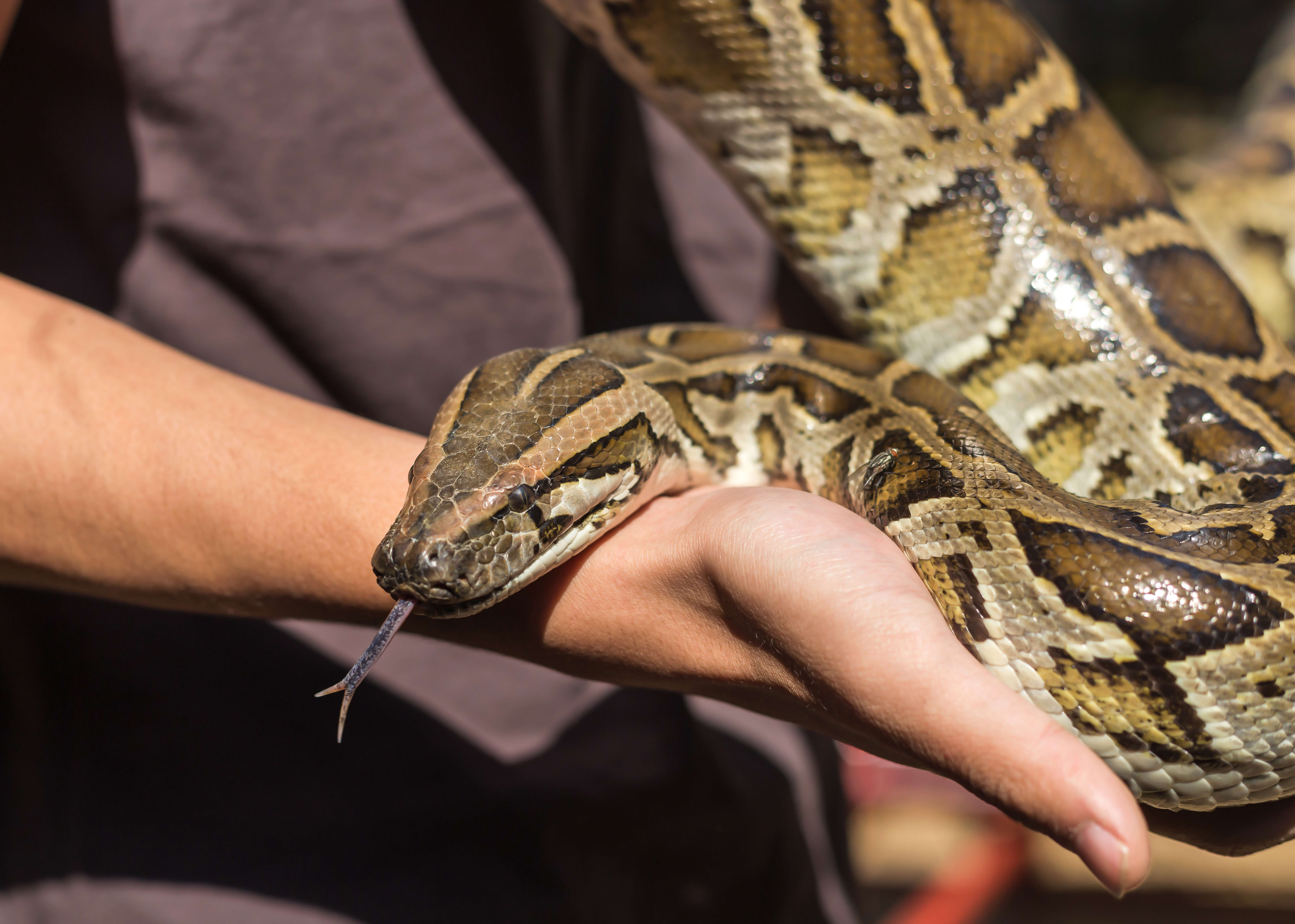Caring for a Burmese Python requires extensive planning, education, and supervision. Today our South Wilton vets provide information that should be considered before owning a pet Python.
Facts about Burmese Pythons
Burmese pythons are native to the jungles and grassy marshes of Southeast Asia, and a large population can be found in the Florida Everglades. They are among one the top five largest snakes in the world, capable of reaching 23 feet in length and weighing up to 200 pounds. The average length of a python is 12 feet.
Pythons are magnificent reptiles with unique markings of dark brown patches and two lines that run horizontally across the head. They are non-venomous, however, they are capable of taking down animals as large as alligators and deer.
They are known to be solitary animals and are generally docile. When young, they spend much of their time in the trees, but as they grow to full size, and the trees can no longer hold their weight, they transition to ground-dwelling. They often lay submerged in shallow water waiting for prey, and they can stay submerged in water for up to 30 minutes before surfacing for air.
Do Burmese Pythons make good pets?
Having a pet of any kind is a big responsibility. However, owning a potentially dangerous animal requires extensive planning, education, and supervision.
Burmese Pythons require a lot of care and maintenance and are expensive to feed and keep. In general, pythons are best left in the wild.
Are Burmese Pythons Dangerous?
Burmese Pythons are dangerous due to their immense size and their feeding tendencies. When feeding they kill their prey by constriction, coiling their bodies around the animal and squeezing until it suffocates.
Attacks on handlers are not uncommon and can be deadly. Although, pythons will rarely attack people without first being provoked.
If you intend to keep one as a pet, it is recommended that these snakes be handled from a young age and should be frequently held so that you become familiar. They are aggressive feeders and if you only handle the snake to open its enclosure at meals, your snake may associate you with food. Always have a second person present when handling or feeding when they reach adult size, approx. 8 feet.
What does a Burmese python eat?
Burmese pythons are carnivores that primarily feed on small mammals and birds. Growing hatchling pythons need to be fed one to two times per week with mice or rats. Adult pythons are fed less often, every two weeks, with larger prey that is the width of the snake. They can swallow animals up to five times as wide as their head, because of the stretchy ligaments in their jaws.
Pythons have poor eyesight and stalk their prey using chemical receptors in their tongues and heat sensors along their jaws. They use their sharp teeth to seize the prey, then coil their body around the animal, constricting with each exhale until the animal suffocates.
How Long Do Burmese Pythons Live?
In the wild, the average life span of a python is 20 to 25 years. It is important to consider this when deciding whether to acquire a python as a pet. It is not easy to find someone to take a giant snake if you are no longer able to care for it, especially a full-grown python.
Common Health Problems?
Burmese pythons are susceptible to respiratory infections and mouth rot. One of the most severe ailments of pythons is inclusion body disease, a fatal virus with symptoms of abnormal shedding, anorexia, constipation, tremors, and loss of motor control. Many snakes with this disease will starve to death.
It is essential to have an exotics veterinarian who specializes in reptiles check your Burmese python annually for signs of disease.
Do you have a Burmese Python in need of veterinary care? Contact our South Wilton vets to book an examination today. Our exotic companion animal vet can help you to provide the best care possible to your python.
Looking for a vet in South Wilton?
We're always accepting new patients, so contact our veterinary hospital today to book your pet's first appointment.
Related Articles View All
C-Section for Dogs: Everything You Should Know
Our South Wilton vets share some information about c-sections in dogs, when they might be needed, and what you can expect.
Enucleation: Eye Removal in Cats & Dogs
Learning that your cat or dog needs eye removal surgery can be upsetting, and you'll probably have many questions. Our veterinarians in South Wilton explain pet eye removal, recovery times, potential complications, and more.
Understanding Blood Tests for Dogs
Dogs and cats often require diagnostic blood tests to reveal vital health information about underlying health conditions. In this post, our veterinarians at South Wilton explain the significance of these tests for pets.
What Are the Symptoms of a Spider Bite on a Dog?
In some cases, the spider bites our South Wilton vets see on dogs cause serious symptoms that necessitate immediate medical attention; however, most spider bites on dogs cause minor irritation but are generally harmless.


